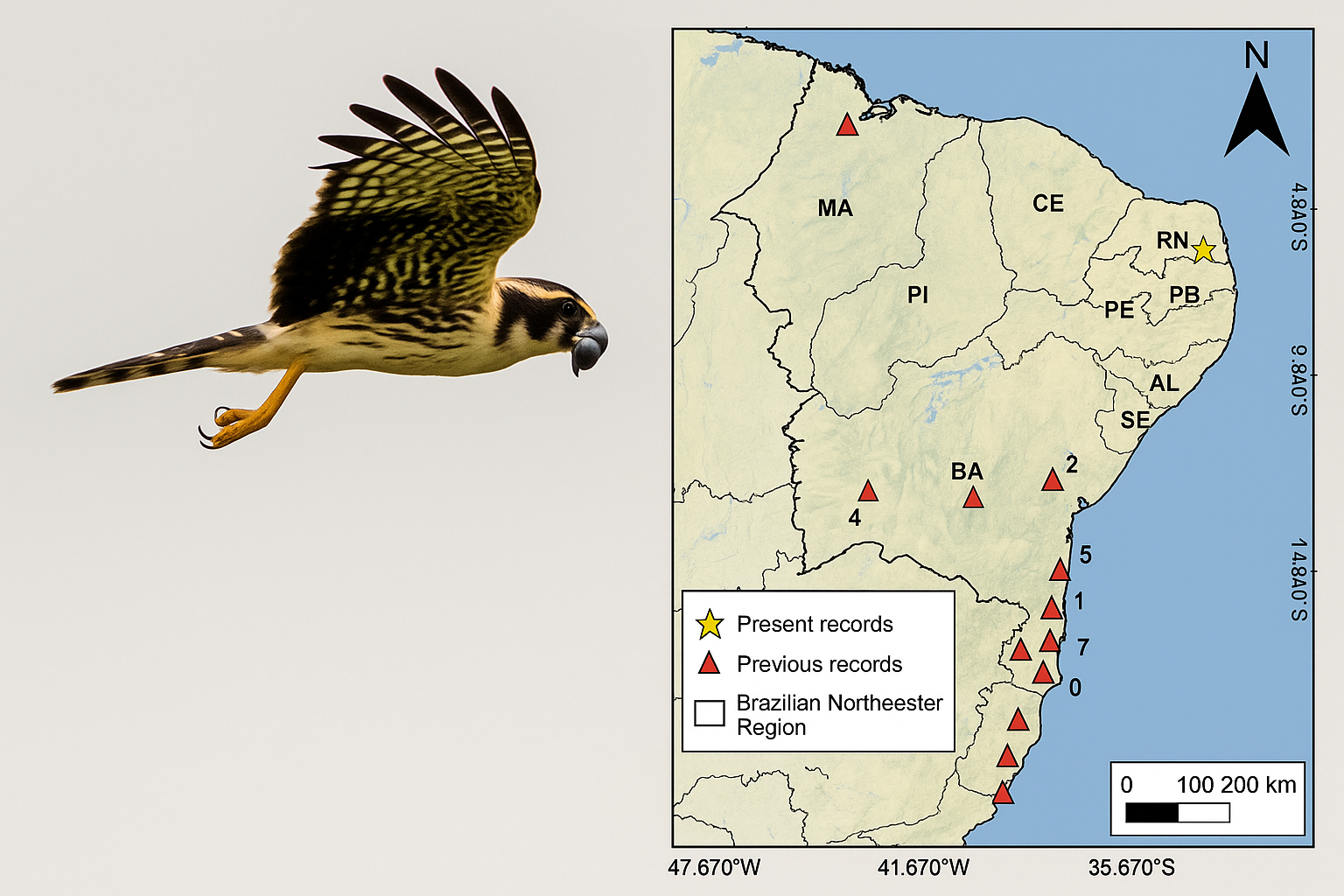First record of the long-winged harrier, Circus buffoni (Aves, Accipitridae) from the Northeastern extreme of Brazil
DOI:
https://doi.org/10.14295/bjs.v4i11.783Keywords:
Accipitridae, reproduction, migration, Circus generaAbstract
We present the first record of the Long-winged harrier, Circus buffoni (Gmelin, 1788), from the state of Rio Grande do Norte, in the Northeastern extreme of Brazil, specifically, the East Potiguar Microregion, which is located within the Atlantic Forest phytogeographic domain. During the study, we recorded at least two individuals between January and June, and recorded their foraging behavior and predation events. We also compiled all published data available on C. buffoni, as well as records from ornithological collections and online databases, which resulted in a total of 13 documented records for the Brazilian Northeast. Breeding populations of C. buffoni are known to exist in both northern and southern South America, providing conflicting evidence on the possible origin of the study individuals and their migratory patterns in Brazil. Given the persistent lacunas in our understanding of the dispersal patterns of Circus buffoni, we recommend further surveys in areas with similar habitats to provide more comprehensive data for defining the species' distribution in South America and its migratory patterns.
References
Baladrón, A. V., Cavalli, M., Pretelli, M. G., & Bó, M. S. (2016). Time-activity budgets and hunting behavior of the Roadside Hawk (Rupornis magnirostris) and the Long-winged Harrier (Circus buffoni). Revista Brasileira de Ornitologia, 24(3), 197-203. DOI: https://doi.org/10.1007/BF03544346
Bierregaard, R. O., & Kirwan, G. M. (2024). Long-winged Harrier (Circus buffoni), version 1.1. In: Birds of the World (J. del Hoyo, A. Elliott, J. Sargatal, D. A. Christie, E. de Juana, and F. Medrano, Editors). Cornell Lab of Ornithology, Ithaca, NY, USA. https://doi.org/10.2173/bow.lowhar1.01.1 DOI: https://doi.org/10.2173/bow.lowhar1.01.1
Camilotti, V. L., Krügel, M. M., & Hartz, S. M. (2008). Nidificação de Circus cinereus (Aves, Accipitridae) na região da fronteira oeste do Rio Grande do Sul, Brasil. Revista Brasileira de Ornitologia, 16(4), 363-365.
Ferguson-Lees, J., & Christie, D. A. (2001). Raptors of the World. Christopher Helm, London, UK.
Godoi, M. N., Filho, J. C. M., Faxina, C., Modena, E. S., Pivatto, M. A. C., Manço, D. G., Bocchese, R., Teribele, R., Rosa, A. L. M., & Stavis, V. K. (2012). Aves de rapina raras no estado de Mato Grosso do Sul, Brasil. Atualidades Ornitológicas, 170, 41-47.
del Hoyo, J. & Collar, N. J. (2014). The HBW/BirdLife International illustrated checklist of birds of the world. Barcelona: Lynx Editions.
Mendes Junior, E., & Farias, H. T. M. (2024). Raízes antigas, novas histórias: proposta de área visitável para o Parque Municipal Boca da Mata. Revista Projetar-Projeto e Percepção do Ambiente, 9(3), 199-208. DOI: https://doi.org/10.21680/2448-296X.2024v9n3ID37451
Menq, W. (2016). Aves de rapina e suas diferentes estratégias de caça - Aves de Rapina Brasil. Available at: http://www.avesderapinabrasil.com/materias/estrategias_caca.htm. Accessed on March 20, 2025.
Oatley, G., Simmons, R. E. & Fuchs, J. (2015). A molecular phylogeny of the harriers (Circus, Accipitridae) indicate the role of long distance dispersal and migration in diversification. Molecular Phylogenetics and Evolution, 85, 150-160. DOI: https://doi.org/10.1016/j.ympev.2015.01.013
Piacentini, V. Q., Ghizoni-Jr, I. R., Azevedo, M. A. G., & Kirwan, G. M. (2006). Sobre a distribuição de aves em Santa Catarina, Brasil, parte I: Registros relevantes para o Estado ou inéditos para a Ilha de Santa Catarina. Cotinga, 26, 25-31.
Pinto, O. M. O. (1938). Catálogo das aves do Brasil e lista dos exemplares que representam no Museu Paulista. Revista do Museu Paulista, 22(1937), 1-566. DOI: https://doi.org/10.5962/bhl.title.99663
Sagot-Martin, F., Lima, R. D., Pacheco, J. F., Irusta, J. B., Pichorim, M., & Hassett, D. M. (2020). An updated checklist of the birds of Rio Grande do Norte, Brazil, with comments on new, rare, and unconfirmed species. Bulletin of the British Ornithologists' Club, 140, 218-298. DOI: https://doi.org/10.25226/bboc.v140i3.2020.a2
Smith, K. G., Wittenberg, S. R. Macwhirter, R. B., & Bildstein, K. L. (2020). Versão 1.0. Northern Harrier (Circus hudsonius), version 1.0. In Birds of the World (P. G. Rodewald, Editor). Cornell Lab of Ornithology, Ithaca, NY, USA. https://doi.org/10.2173/bow.norhar2.01 DOI: https://doi.org/10.2173/bow.norhar2.01
Somenzari, M., Amaral, P. P. D., Cueto, V. R., Guaraldo, A. D. C., Jahn, A. E., Lima, D. M., Lima, P. C., Lugarini, C., Machado, C. G., Martinez, J., & Nascimento, J. L. X. D. (2018). An overview of migratory birds in Brazil. Papéis Avulsos de Zoologia, 58, e20185803. DOI: https://doi.org/10.11606/1807-0205/2018.58.03
Souza Petersen, E., Petry, M. V. & Krüger-Garcia, L. (2011). Utilização de diferentes hábitats por aves de rapina no sul do Brasil. Revista Brasileira de Ornitologia, 19(3), 376-384.
Winkler, D. W., Billerman, S. M., & Lovette, I. J. (2020). Hawks, Eagles, and Kites (Accipitridae), versão 1.0. In: Birds of the World (S. M. Billerman, B. K. Keeney, P. G. Rodewald, and T. S. Schulenberg, editors). Cornell Lab of Ornithology, Ithaca, NY, USA. https://doi.org/10.2173/bow.accipi1.01 DOI: https://doi.org/10.2173/bow.accipi1.01

Downloads
Published
How to Cite
Issue
Section
License
Copyright (c) 2025 José Arthur Felipe Pequeno, Hilda Raianne Silva de Melo, Mauro Pichorim

This work is licensed under a Creative Commons Attribution 4.0 International License.
Authors who publish with this journal agree to the following terms:
1) Authors retain copyright and grant the journal right of first publication with the work simultaneously licensed under a Creative Commons Attribution License that allows others to share the work with an acknowledgement of the work's authorship and initial publication in this journal.
2) Authors are able to enter into separate, additional contractual arrangements for the non-exclusive distribution of the journal's published version of the work (e.g., post it to an institutional repository or publish it in a book), with an acknowledgement of its initial publication in this journal.
3) Authors are permitted and encouraged to post their work online (e.g., in institutional repositories or on their website) prior to and during the submission process, as it can lead to productive exchanges, as well as earlier and greater citation of published work.



